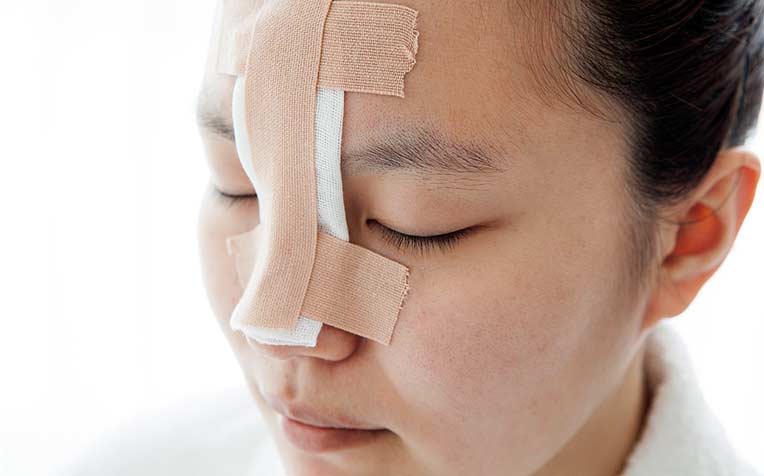
Rhinoplasty surgery recovery can take up to 3 weeks before most patients are comfortable with returning to work or school.
What do you expect immediately after your rhinoplasty surgery?
"Immediately after recovering from the anaesthesia, you would notice that your nose will be packed with soft nasal packing and there may be tapes and a splint over your nose to reduce swelling and protect it. You will be breathing through your nose and there may be some trickling of blood to the back of your throat. Most patients can be discharged on the same day and some may require 1 over-night stay for observation," says Dr Terence Goh, Visiting Consultant, Department of Plastic, Reconstructive & Aesthetic Surgery, Singapore General Hospital (SGH), a member of the SingHealth group.
First 48 hours after rhinoplasty surgery: What should you do at home?
Swelling, bruising and discomfort are normal symptoms 48 hours after rhinoplasty surgery. Here are 7 things you should do at home to take care of your post-rhinoplasty wound.
- Try to keep your head elevated at 30-40 degrees on 2 pillows.
- You should avoid activity that may increase the chance of bleeding such as physical exertion and bending actions.
- Avoid hot drinks and food for the first few hours as this may cause additional bleeding.
- There will be a gauze placed under your nose. This should be changed as needed for the first 24 hours.
- Take your medications as directed.
- Keep the nasal tapes and splint dry so that your nose will be comfortable.
- Apply the antibiotic ointment 3-4 times a day to the suture lines.
What you will expect after your rhinoplasty surgery?
Swelling varies from patient-to-patient. It is usually worst in the first 3 days before it starts to settle. I routinely review my patients on the 5th post-surgery day to remove the stitches. When the nasal splint is removed at this point, the nose may appear more swollen and up-turned. This is to be expected. Most of the swelling should resolve over the next two weeks.
At the end of the two weeks, most patients will be comfortable with returning to their work or school; however 3 weeks would be ideal, depending on the degree of privacy you want to maintain.
The swelling will continue to improve over the next few months with optimal results at 12 months. Do expect minor fluctuations in the swelling of the nose over the course of the next few months.
Bruising will vary like swelling from person to person. Most bruising, if it occurs, should resolve over the first 10 days. It will turn from pink/red to a purple/bluish colour before it becomes green and finally orange and then it fades away.
Nasal Drip. Some patients have allergic rhinitis or persistent nasal drip after rhinoplasty. We will prescribe a course of antihistamines to help you to reduce the nasal drip.
Numbness. Your nose will be numb following surgery. This is normal and the numbness will subside over the next few weeks to months.
Occasionally you will feel pins and needles and this is a sign of the body healing. The nose will be hyper-sensitive during this time and accidental brushes against the nose may cause pain that is more severe than normal.
Bleeding. Depending on the surgery performed, you may have some residual bleeding from inside the nose. This may trickle to the back of the throat or through the nose.
If bleeding occurs:
- Lie down with your head elevated.
- You may pinch the sides of the nose gently and swallow the blood.
- Apply cold compression over the forehead
Check out our other rhinoplasty articles:
Rhinoplasty: Reconstructive vs Aesthetic Nose Jobs
Cleft Rhinoplasty: Cleft Lip and Nose Reconstruction
Post-Cancer Rhinoplasty: Nose Job to Correct Deformities
Asian Rhinoplasty: What is the Difference and What has Changed?
Ref: N18
Contributed by

















 Get it on Google Play
Get it on Google Play